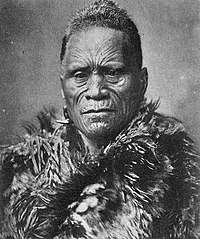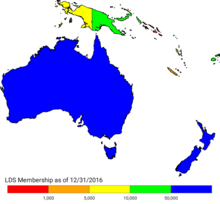Pacific Islanders and Mormonism

Pacific Islanders have a particular place in the history of the
Since the 1850s
History

The Pacific islands were one of the first areas to be
Hagoth
In addition to the LDS Church's stories about people sailing to the New World, there is also the story of Hagoth (
Folklore

Some of the folklore that exists in the relationship of the LDS Church and Pacific Islanders include:
- Polynesian leader Tāwhiao accurately predicted the site of the 1958 Hamilton New Zealand Temple before his death in 1894;[26]: 125
- Paora Te Potangaroa and Tāwhiao, predicted the coming of Latter-day Saint missionaries to New Zealand;[29]
- During the attack on Pearl Harbor on December 7, 1941, Japanese aircraft pilots attempted to bomb or strafe the church's Laie Hawaii Temple, but were prevented due to a mechanical failures or unseen protective force.[26]: 166 An LDS-source stated that the Japanese pilot who attempted to bomb or strafe the Laie Hawaii Temple was converted to the LDS Church after he saw a picture of the temple in the possession of Latter-day Saint missionaries in Japan.[26]: 168
Temples
Although there is a sparse population, and great distances to travel, the Oceania region has a number of church temples due to the significant numbers of members in many countries. There are also temples in the Philippines and Australia.
| Map | Country | Image | Temple | Location | Status / Dedication date | Floor area | ||||||
|---|---|---|---|---|---|---|---|---|---|---|---|---|
|
||||||||||||
| Fiji | Suva Fiji Temple | edit | Suva, Fiji | June 18, 2000 | 12,755 sq ft 1,185.0 m2 | |||||||
| French Polynesia | Papeete Tahiti Temple | edit | Papeete, Tahiti, French Polynesia | October 27, 1983 | 12,150 sq ft 1,129 m2 | |||||||
| Hawaii | Kona Hawaii Temple | edit | Kailua-Kona, Hawaii, U.S. | Closed for renovation | 10,700 sq ft 990 m2 | |||||||
| Laie Hawaii Temple | edit | Laie, Hawaii, United States
|
November 27, 1919 | 42,100 sq ft 3,910 m2 | ||||||||
| New Zealand | Hamilton New Zealand Temple | edit | Hamilton, New Zealand | April 20, 1958 | 45,251 sq ft 4,204.0 m2 | |||||||
Samoa
|
Apia Samoa Temple | edit | Apia, Samoa | August 5, 1983 | 18,691 sq ft 1,736.5 m2 | |||||||
Apia Samoa Temple (original)
|
edit | Apia, Samoa | Destroyed | 14,560 sq ft 1,353 m2 | ||||||||
| Tonga | Nuku'alofa Tonga Temple | edit | Nukuʻalofa, Tonga | August 9, 1983 | 21,184 sq ft 1,968.1 m2 | |||||||
Demographics
 |
 |
Book of Mormon translations

- 1855, Hawaiian language translation of the Book of Mormon, which was the first translation of the Book of Mormon to be published in a non-European language.
- 1889: Māori edition.
- 1903: Samoan edition.
- 1904: Tahitian edition.
- 1946: Tongan edition.
- 1965: Rarotonganedition.
- 1980: Fijian edition.
- 1981: Niuean edition (selections)
- 1987: Pohnpeian, Micronesian languages (selections).
- 1988: Palauan edition.
- 1989: Chamorro edition.
- 2001: Gilbertese (Kiribati) edition.
- 2002: Tok Pisinedition.
- 2003: Marshallese edition.
- 2004: Bislamaedition.
- 2004: Yapese edition.
- 2015: Kosraean edition, Micronesian languages.
- 2015: Chuukese/Trukese edition, Micronesian languages.
Portrayals in media
- Johnny Lingo
- The Other Side of Heaven
- The Legend of Johnny Lingo, a remake of the 1968 film.
Notable Pacific Islander Latter-day Saints

LDS Church members from indigenous groups:
Political Figures
- Princess 'Elisiva Fusipala Vaha'iof Tonga
- William Sio, New Zealand MP
- Elizabeth Kikkert, ACT MLA
Artists
- Naomi Kahoilua Wilson
- The Jets, Tongan American pop and R&B family band
- 5th Harmony
Athletes

- Sid Going, All Blacks captain, and player for NZ Maori.
- Ken Going, All Blacks player, member of the NZ national side on the 1974 tour of Ireland.
- Jonah Lomu, joined the Church in 2012, 3 years before his passing
- Valerie Adams, Tongan, New Zealand Shot Putter world champion, Olympic and Commonwealth Gold Medalist
- Willie Brown
- Tony Finau, PGA Tour professional golfer
- Pearl Going, NZ mountaineer.
- William Hopoate, Prominent NRL Bulldogs player.
- John Hopoate
- Todd Miller
- Ken Niumatalolo, Coach of the Navy Midshipmen football team
- Brendon Pongia, New Zealand basketball player
- Jordan Rapana, NRL Canberra Raiders, NZ and Cook Island national teams
- Sam Perrett, NRL Sydney Roosters and Bulldogs
- Lloyd Perrett, NRL Bulldogs and Manly Sea Eagles
- Leilani Rorani, Former NZ squash player
- Vai Sikahema, Tongan, NFL player
- Kalani Sitake, Coach of the Brigham Young University Cougars football team
- Nooa Takooa, sprinter.
- South Pacific Gamesgold medalist
- Manti Te'o, Samoan NFL player from Hawaii
See also
- List of Mormon missionary diarists (Pacific)
- LDS membership statistics
- Native American people and Mormonism
- Black people and Mormonism
Notes
References
- ^ ISSN 1092-6690.
- ^ ISSN 0012-2157.
- ^ a b [1]: 85 [2]: 55
- ISBN 978-0-8425-2696-8 – via Internet Archive.
- ^ ISSN 0012-2157.
- ^ [1]: 85–86, 93 [4]: 39–40, 44–46 [5]: 91–97
- LDS Church.
- ^ Alma 63:5–8
- ISSN 0022-4227.
- ^ Parsons, Robert E. "Hagoth and the Polynesians". In Nyman, Monte S.; Tate, Charles D. Jr. (eds.). The Book of Mormon: Alma, the Testimony of the Word. Religious Studies Center at Brigham Young University.
- ^ a b [5]: 91–97 [9][10]
- LDS Church. July 9, 1988.
- LDS Church. 2009. p. 261.
- LDS Church. 2000. p. 143 – via Internet Archive.
- LDS Church.
Since the days of George Q. Cannon in Hawaii (1851–54), the Church leaders had more and more frequently alluded to the idea that the Polynesians were descendants of Lehi, the early Book Of Mormon prophet. Although the relationship between the Polynesian peoples and the alleged "adventurer" Hagoth (see Alma 63:5–8) is not clear—he being a Nephite and the Polynesians appearing to be Lamanites—Church leaders have time and time again referred to the Polynesians as children of Lehi.
- ^ LDS Church. December 2000.
- LDS Church.
- ^ a b Britsch, R. Lanier (June 1981). "Maori Traditions and the Mormon Church". New Era.
- .
- Newspapers.com.
- S2CID 165766064.
However, Mormons would continue to proselytize among 'black-skinned' Pacific Islanders, East Indians, and South Americans because of their supposed Israelite blood.
- ISSN 0066-4677.
- ^ [19][20][21][22]: 128–129
- LDS Church.
- ^ Simon, Hemopereki Hōani (Fall 2022). "Mormonism and The White Possessive: Moving Critical Indigenous Studies Theory into The Religious Realm" (PDF). Journal for Cultural and Religious Theory. 21 (3): 360.
- ^ ISBN 0-8425-2480-0.
- ^ Cowley, Matthew (September 1950). "Maori Chief Predicts Coming of L.D.S. Missionaries". Improvement Era. Vol. 53, no. 9. pp. 696–698, 754–756 – via Internet Archive.
- Deseret Book. pp. 200–205.
- ^ [27][28][26]: 107–126 [18]

